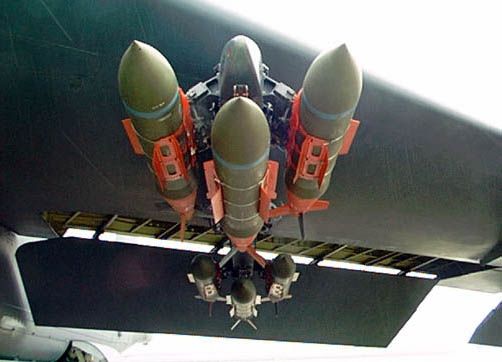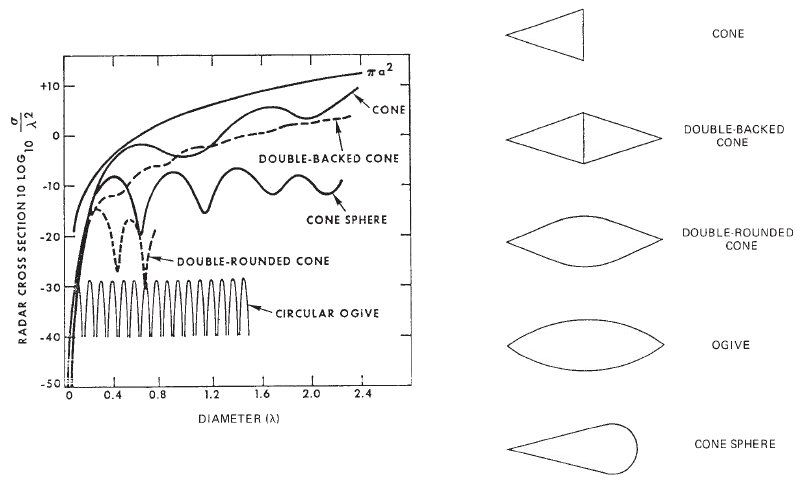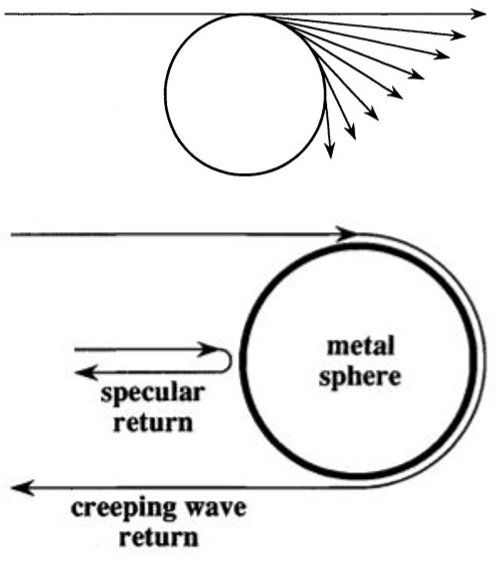The refresher in wave theory was appreciated.. since its been a while since I took that course.. but the object of my question was how those visual similarities between the delta platform of the J-20 and the platform of the YF-22 may allow for a certain approximation of having similar characteristics in return.
What I posted was for the benefits of the interested lay readers as well. But for your current question, I am going to have to tread very carefully here...
The RCS control tactic goes: Model, Predict, and Measurement.
With computer assist, 'super' or not, the 'Model' and 'Predict' are often interchanged. But 'Measurement' always have the final words: Yea or Nay (dumbass).
Based upon what we know of the above simple shapes and how they would respond, we can take a step up and model/predict how these shapes would respond in combination with each other. We have done such modeling/predicting and our measurement, which is the final step in any RCS control experiment, have bear out our modeling/predicting. As the complex body increases in complexity in terms of shape combinants to include their sizes, our modeling/predicting equally increases in complexity and of course, errors when measurements do not support our theories. Then it is back to the proverbial drawing board.

If modeling/predicting is that easy to support by measurements, we would not be enclosing the above RCS mess, as in 'internalizing' them in some ways, fuselage or RCS controlled 'pods'. But what we also do know is that complex structures on a complex body do exhibit identifiable signal characteristics and our problem have always been discernment then extraction of those characteristics out of the background. The greater the complexity, the greater the uniqueness of those characteristics, but not necessarily in amplitude since destructive interference will deny us that factor.
A wing is a much more complex structure than the sphere or a cylinder but far less than a cluster of missiles and bombs as shown above. So have anyone in the 'stealth' arena did a study on the ranges of these signals, from the simple sphere to a cluster of cylinders and plates (missiles and bombs), to anywhere in the middle? Yes, we did. Anyone else? I do not know.
Here is where I must tread carefully and I will use
PUBLICLY available sources to give you a hint of what we 'may' have in store for potential 'stealth' aspirants...
IEEE Xplore - Abstract Page
Cluster Sorting of Radar Signals Using Intra-pulse Feature
Author(s): Song Yunzhao Univ. of Electron. Sci. & Technol. of China, Chengdu
Wan Qun ; Liu Gang
Common parameters for signal description can hardly meet practical requirement of radar signal sorting and recognition. Aiming at the problem of signal sorting system, DCT (discrete cosine transform) features and BT (product of bandwidth and time width) feature are introduced to form a new description vector. DCT features not only can reflect modulation mode but also are not sensitive to noise. BT feature can reflect some parameters of modulation. Both of DCT features and BT feature are easy to get. At last, results of weighted dynamic cluster show that DCT features and BT feature are effective for sorting.
What the abstract really mean is that we are trying to extract a cluster of signals that are related to each other in some significant ways. The signals
MUST relate to each other.
First...The words 'Cluster Sorting'...
The above is an example of such a cluster or 'clustering' of signals and whose discrete members are related to each other by virtue of their parent -- the aircraft.
The floor represent a threshold and that is usually the 'clutter rejection threshold'. Clutter is extremely problematic in radar detection. What 'clutter' is -- Is a set of signals that matches a library of signal characteristics that we
IMMEDIATELY discard. Primary in that library is amplitude. Cosmic background radiation (CBR) is a member in that library. Do we want CBR to be on our scope? No. But our astronomer pal would want to study this CBR thingie. We do not want to see birds, but our ornithologist pal does. We do not want to see hyrdometeors, but our meteorologist pal does. So what clutter really mean is that it is completely arbitrary. One man's junk is another man's treasure. The library and line that represent clutter processing depends on what one is looking for (above) and discarded signal characteristics that matches said library (below). A radar engineer can spend his entire professional career --
DECADES -- just working on clutter processing, then retire in comfort to a boathouse in Florida.
Now...The words 'Intra-pulse'...
The above is an example of the basic characteristics of a standard radar pulse transmission. The words 'Intra-pulse' refers to the periods of 'silence' or non-transmission between each pulse.
Not the PRI.
NOT.
The PRI is measured either from leading edge to leading edge or trailing edge to trailing edge. The intra-pulse period is measured from trailing edge to leading edge.
The problem for 99% of the world's radars regarding 'stealth' is that the aircraft produces a set of signal characteristics that matches the most commonly known clutter libraries that contains: birds, insects, hydrometeors, flora, and fauna. When you buy a radar system, civilian or military, these libraries are already included either by hardware via electronics engineering of interchangeable circuit boards or by software. Usually a combination of both.
The 'non-stealth' aircraft produces a cluster of signals that rises above the clutter rejection threshold, hence it is 'detected' and 'tracked'. The individuals of this cluster have one thing in common with each other: amplitude. Cluster sorting by amplitude alone is sufficient to 'detect' and 'track' this target.
The 'stealth' aircraft produces a cluster of signals that
DOES NOT rises above the clutter rejection threshold, hence the entire cluster is 'discarded'. The individuals of this cluster also have one thing in common with each other: amplitude. But much much much less of it. So cluster sorting by amplitude alone is insufficient. We dare not lower the clutter rejection threshold because we would be overwhelmed by so much raw data. But if we have no choice but to lower this threshold, we must find some other ways to process the raw data based upon signal characteristics other than amplitude.
An aircraft is a complex body comprised of diverse shapes, from spheres to spheroids to plates to ovoids to cylinders to half cylinders to ogives and so on. The sharp transitions from one shape to another -- surface discontinuities -- and from one material to another -- medium discontinuities -- are what made an aircraft 'non-stealth'. A 'stealth' aircraft is still a complex body except that it has much lower incidences (events) of surface discontinuities and medium discontinuities. But if a surface discontinuity and/or a medium discontinuity must exist, and they do exist, the next goal is to deny the seeking radar the availability of the signals produced and if that denial is not possible, then reduce the intensity of that availability. Put it another way: Both the denial of availability and the reduction of intensity of what is available made an aircraft 'stealthy', based upon the clutter rejection threshold, of course.
We know from long ago that complex bodies produces different signal characteristics based upon the diverse shapes and relationships of those shapes. What the authors are putting forth is an attempt at data processing of what happens to a target with respect to the clutter rejection threshold by analyzing the target's clustering characteristics
BETWEEN pulses.
Here is how...
Because the target in question is a moving target across a
KNOWN background that is usually discarded as 'junk' or clutter, the target will produce a phase shift that could occur from pulse to pulse. The 'junk' or clutter' will not produce such a phase shift.
The proposed method would:
- Analyze
EACH signal inside the clutter rejection threshold, from pulse to pulse,...
- Search for phase shifts from pulse to pulse,...
- Determine if these phase shifts are in a cluster,...
- Determine if the background clutter produces any phase shifts,...
- Cancelation of any non-shifting signals.
Then declare a 'target' or not. Hence the words 'Intra-pulse'. The potential for false target declaration is great because of dependencies on avionics hardware and/or software sophistication. However,
IF the system is comprised of physically and spatially distinct antenna arrays technique called 'displaced phase center'...
Theory of displaced phase center antenna for space based radar applications
A theory of the displaced phase center antenna system for space based on radar applications is presented. The matching condition required to compensate for the motion of the satellite platform so that clutter cancellation can be achieved is first derived. Analytical expressions for the signal and clutter covariance matrices are given. With the aid of a simplified model, numerical values of an improvement factor are obtained. These results illustrate the dependence of the level of clutter rejection on radar parameters such as: grazing angle, pulse train duration, pulse repetition rate, and antenna aperture size.
Phased Arrays and Radars
Clutter Rejection for an Airborne System (STAP and DPCA)
To cope with ground clutter and sidelobe jamming for airborne radar, extensive work is ongoing toward the development of an airborne phased array using space-time adaptive processing (STAP).25,26 STAP is a general form of displaced phase center antenna (DPCA) processing. STAP had been demonstrated several years ago on a modified E2-C system by NRL.27,28 More recently, a flight demonstration STAP provided 52 to 69 dB of sidelobe clutter cancellation relative to the main beam clutter.29 This system used an array mounted on the side of an aircraft. The antenna had 11 degrees of freedom in azimuth and two in elevation, for a total of 22. Before STAP, the antenna RMS sidelobe level was -30 dBi; with STAP, it was 45 dBi.
...Then this potentiality is removed but currently it is not yet feasible for something small like a fighter aircraft, which does not have sufficient volume space to carry two antennas and to space them apart to take the full effect. Data processing is intensive because the system is effectively processing everything from CBR to birds to insects to flora and to fauna. The system does not lower its clutter rejection threshold, it simply uses it as a reference, so in a way, the word 'rejection' here is a bit of a misnomer. The system can even have a dynamic clutter rejection threshold capability based upon situational needs, but that would increase the data processing requirement to cover all possible tactical scenarios. So to date, only something as large like an AWACS can have this DPCA capability.
The results are extremely dramatic...
Dual antennas for DPCA capability is not an option for small aircrafts. Cluster sorting via intra-pulse analysis is one of
MANY techniques and is a more attractive possibility for a single antenna system but is limited to just the PRI. Keep in mind that this single antenna system is also limited in scan direction and area.
Frequency is probably the most talked about characteristic of anything related to EM discussions, particularly the phrase 'frequency hopping'. The more precise phrase is 'frequency agility'. Some radar systems are more frequency agile than others, at the expense of system hardware and cost, of course. But as we can see above with the illustration containing all the basic signal characteristics of a transmission, frequency is not the only signal characteristic in a typical radar transmission. If our system is more capable, we would have 'parameters agility', meaning the ability to manipulate -- at will -- all signal characteristics of a transmission.
For example...
The typical AM radio signal is amplitude agile. The FM side is frequency agile. The above example is the lesser known PRI agile or PRI 'jittering' in electronics warfare jargon. Data analysis of complex returned signals from a PRI agile transmission is already possible. The probability of a radar system to have this capability is another issue. Now add in amplitude, frequency, bursts of continuous wave (CW), and many other combinations. Each combination have been studied (by US) to see what kind of signal a certain planform will produce.
So if we know that complex bodies will produce complex variations of signals, from phase shifts to Doppler to amplitude and so on, is it possible to have a single antenna system sophisticated and powerful enough and is equipped with a comprehensive library of clustered signals characteristics to fully exploit parameters agility to detect low radar observable aircrafts? Yes.
We
ALREADY know what a 'delta wing' look like as far as complexity of returned echo goes. As long as one aircraft give us a reference signal, we can extrapolate with high confidence of precision and accuracy what a smaller or larger delta wing will look like. A canard is just another wing. It is a 'canard' by virtue of physical placement but its aerodynamics and EM characteristics are no different than the 'wing'. But because of its size and physical location on a complex body, the final set of signal characteristics will be different than that of the 'delta wing' and the fuselage. We know what this set of signal characteristics look like.
Dual antennas for DPCA capability is largely hardware based for discernment and extraction of unique clusters inside a background. Pulsed transmissions with parameter agility is another method for the same desire. You can bet your next year's salary that there are more methods than what I have presented here.
I made no claims on exact figures but based upon the visual similarities of planforms and upon what I know from my own experience, I will 'opine'

that we (the US) know what each planform look like under EM bombardment and those libraries will be waiting for the next 'stealth' aspirants.
Coming to the question of bursts.. I am well aware of it since triangulation of a burst is difficult but since it does still give itself away.. Can one avoid even that?
No warning at all. yet communications continue between a stealth aircraft flight group(and no I dont mean hand signals

)
It does give itself away, of course. But a reasonably directional communication method can further reduce the odds of detection...
The initials 'CNI' stands for: Communication, Navigation, and Identification.
That is what the USAF chose to disseminate to the public. Now you know why the F-22 is called 'an antenna farm'. Between each fighter, the entire system can passively monitor each friendly aircraft's position and will use only the appropriate antenna for these data transmission bursts.
Then you add in this...
around 1998-99 we successfully hid signal in background noise. We used wavelets and stochastic statistical algorithms to retrieve the information.
Not easy though .
And the odds of detection by a hostile force is reduced even further.
A flight of 4 F-22s can divide the sky into discrete areas of responsibility for each aircraft with everyone in 99% passive detection mode and communicate with each other using only physically discrete antennas.
Now multiply this capability at least twice for the F-35.



















 )
)





 that we (the US) know what each planform look like under EM bombardment and those libraries will be waiting for the next 'stealth' aspirants.
that we (the US) know what each planform look like under EM bombardment and those libraries will be waiting for the next 'stealth' aspirants.